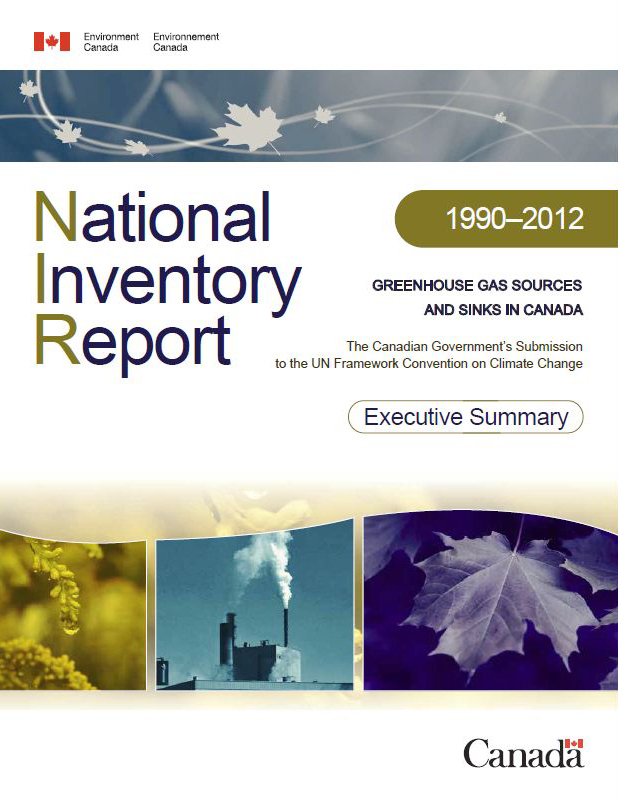You are here
National Inventory Report 1990-2012: Greenhouse Gas Sources and Sinks in Canada - Executive Summary
Primary tabs
 ec.gc.ca
ec.gc.ca
Introduction
The United Nations Framework Convention on Climate Change (UNFCCC) is an international treaty established in 1992 to cooperatively tackle climate change issues. The ultimate objective of the UNFCCC is to stabilize atmospheric greenhouse gas (GHG) concentrations at a level that would prevent dangerous interference with the climate system. Canada ratified the UNFCCC in December 1992, and the Convention came into force in March 1994. At the 15th session of the Conference of the Parties (COP15) to the UNFCCC in 2009, Canada signed the Copenhagen Accord, under which Canada has committed to reducing its GHG emissions to 17% below the 2005 level by the year 2020.Footnote1
To achieve its objective and implement its provisions, the UNFCCC lays out several guiding principles and commitments. Specifically, Articles 4 and 12 commit all Parties to develop, periodically update, publish and make available to the COP the national inventories of anthropogenic emissions by sources and removals by sinks of all GHGs not controlled by the Montreal Protocol.Footnote2
Canada’s National Inventory is prepared and submitted annually to the UNFCCC by April 15 of each year, in accordance with the December 2005 version of the Guidelines for the preparation of national communications by Parties included in Annex I to the Convention, Part I: UNFCCC reporting guidelines for national inventories. The annual inventory submission consists of the National Inventory Report (NIR) and the Common Reporting Format (CRF) Tables.
The inventory estimates include carbon dioxide (CO2), methane (CH4), nitrous oxide (N2O), sulphur hexafluoride (SF6), perfluorocarbons (PFCs) and hydrofluorocarbons (HFCs), in the following six Intergovernmental Panel on Climate Change (IPCC) sectors: Energy, Industrial Processes, Solvent and Other Product Use, Agriculture, Waste, and Land Use, Land-Use Change and Forestry (LULUCF). The GHG emission and removal estimates contained within Canada’s GHG inventory are developed using methodologies consistent with the inventory guidelines prepared by the IPCC. Given that the underlying data and methodology for estimating emissions are revised over time, emissions levels in all years are subject to change as both data and methods are improved.
Section ES.2 summarizes the latest information on Canada’s net anthropogenic GHG emissions over the period 1990–2012, and links this information to relevant indicators of the Canadian economy. Section ES.3 outlines the major trends in emissions from each of the IPCC sectors.
There are several methods to categorize the sources of GHG emissions. For the purposes of analyzing trends and policies, it is useful to allocate emissions to the economic sector from which they originate. As such, this report also presents emissions by the following economic sectors: Oil and Gas, Electricity, Transportation, Emissions Intensive and Trade Exposed Industries, Buildings, Agriculture, Waste and Others. This is the approach taken for reporting against Canada’s Copenhagen targetFootnote3 in the annual Canada’s Emissions Trends report (Environment Canada 2013) as well as Canada’s Sixth National Communication and First Biennial Report (Environment Canada 2014). Throughout this report, the word “Sector” generally refers to activity sectors as defined by the IPCC for national GHG inventories; exceptions occur when the expression “economic sectors” is used in reference to the Canadian context. Section ES.4 presents a synopsis of GHG emissions by economic sector, consistent with that submitted to the UNFCCC.
Canada is a geographically large federation composed of a federal government, 10 provincial governments, and three territories. Natural resources, including energy, fall mainly under provincial jurisdiction. Section ES.5 details GHG emissions for Canada’s 13 sub-national jurisdictions.
Canada’s annual inventory submission to the UNFCCC embodies over a decade of learning and improvements. Section ES.6 provides some detail on the components of this submission, and outlines key elements of its preparation.
National Inventory Report 1990-2012: Greenhouse Gas Sources and Sinks in Canada - Executive Summary



Recent Comments